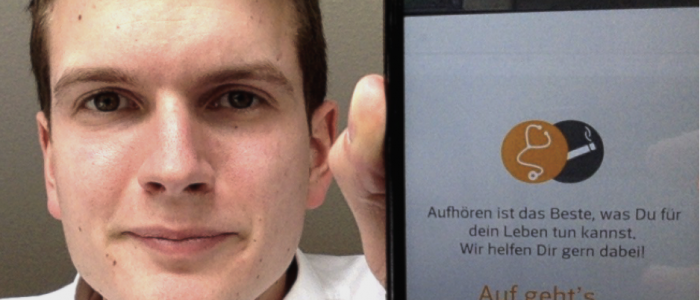Going smoke-free: Titus Brinker introduces the Smokerstop App
Smokerface, and now Smokerstop – these are the “smartphone weapons” of the medical student initiative Education Against Tobacco in the fight for smoke-free school campuses. Both apps are free and were developed on the basis of findings concerning smoking-prevention research. Smokerface has already been available since September. After a user takes a selfie on the app, Smokerface shows them the short and long-term effects of smoking on their own faces. Now the Smokerstop app is available as well and is designed to support those who want to quit smoking. The coding work of Brinker’s innovative app is financed by third-party funds of the German Heart Foundation.
Why the additional App?
“Many fans of the Smokerface app became motivated to stop smoking and asked me what the way of doing this successfully was. Effective medication against smoking is in most cases age-restricted, and also expensive. Group therapy is also not very prevalent or accessible in Germany. There aren’t really any good currently existing apps that I could recommend, and most of them cost money” – Titus Brinker (24).
How it works
Every user is individually supported in their journey to quit smoking – they can enter their own specific smoking habits and their own goals, based on which they receive personalized motivational messages. “Each user receives the thing that doctors often don’t have time for: an individual follow-up”, says Brinker, who for a year now, has been a lecturer for a smoking-prevention elective at the medical faculty at Gießen. “The app also allows them to see, in real time, how their body recovers as they give up smoking. It gives scientifically supported advice on what strategies can increase the probability of successfully quitting smoking as well as preventing weight gain.”
Where does the Smokerstop app fit in with every-day clinical practice?
“In university clinics in Germany, but also overseas, often no time is given to treating smoking habits, even though it’s usually the biggest factor when considering the 5-year survival likelihood for patients affected by conditions such as heart attacks,” says Brinker. There are many reasons why no efforts are made to attempt monitoring a patient’s progress in quitting smoking. One is certainly the lack of training in this area, but the most common reasons are motivation and time, which stressed GPs lack all too often. “A de-addiction program following medical guidelines and regulations and given by a doctor’s recommendation, should always refer the patient to therapy first. However, if time or motivation are an issue, I would suggest that in these situations, doctors should recommend the free app to individual patients – this only takes a few seconds.”
Support and Encouragement from Harvard
One person, who was definitely impressed by Brinker’s idea, was Dr. Anne Fuhlbrigge (MD), the Clinical Director of Pulmonology at the Harvard Medical School Teaching Hospital/Birgham and Women’s Hospital, to whom Brinker had already introduced the app when it was in its test phases. Dr. Fuhlbrigge commented: “I think it is a great idea to show the patient the individual benefits of quitting via a smartphone application while closely following-up with mobile alerts which remind the quitter of his/her goal and achievements.“
You can download the app now for free on your iPhone or Android, or you can recommend the Smokerstop app to smoking friends. Screenshots of the App can be viewed here:

